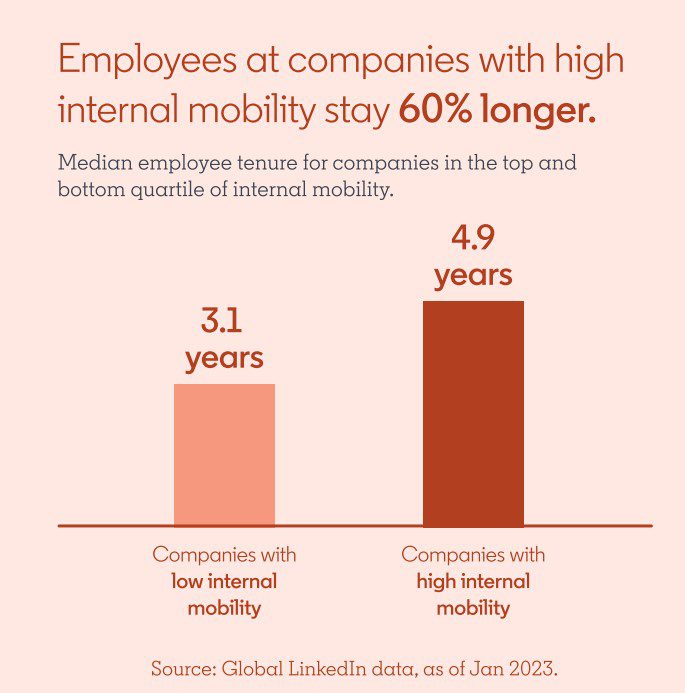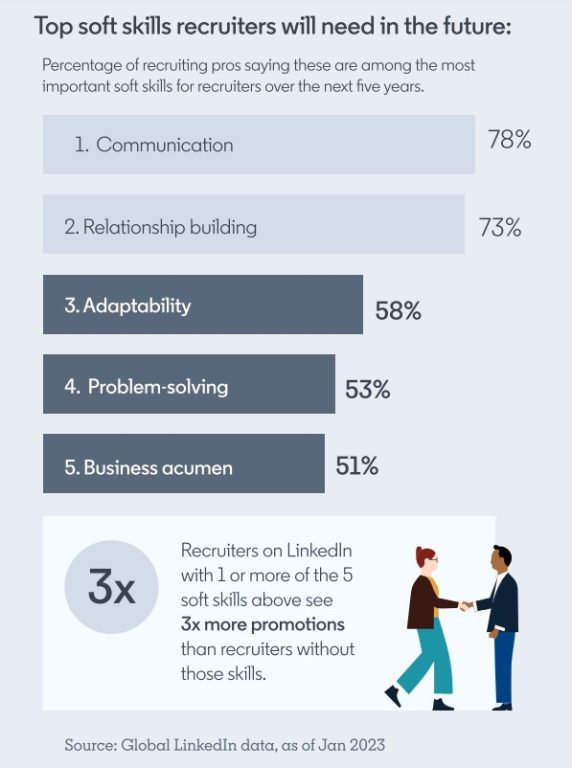Recruiting needs to become more collaboration & skills-focused
According to LinkedIn.
Why You Should Care
Thriving in this economy requires TA and L&D to work closely together.
It's time to focus more on internal mobility and skills.
Find out more from LinkedIn's Future of Recruitment 2023 report.
HR leaders, don’t miss out: Join us in Las Vegas for free as a VIP guest at UNLEASH America.
The world is in an economic crisis – according to Karin Kimbrough, chief economist at LinkedIn, we are heading towards a mild recession (aka one that is short, and not deep) in the UK and the US.
There is slightly more resilience in Germany, and in APAC, particularly India and China, shared Kimbrough at the social media giant’s LinkedIn Forward HR event.
She continued that while there have been layoffs in technology, it is not all doom and gloom; the hiring and labor market remains robust and is returning to pre-pandemic levels.
In this context, recruiters continue to play a vital, strategic role in organizations – especially as the Great Resignation or the Great Reshuffle continues at pace in 2023.
Research by LinkedIn shows that seven in ten talent acquisition (TA) leaders say that their team has a seat at the proverbial table, and 87% believe the recruiting function has become more strategic in the past year. This is based on a survey of over 1,600 global TA leaders by the social media platform.
It’s time to for L&D and TA to collaborate
A more strategic TA team is one that works in partnership with other departments, both within and outside HR, according to LinkedIn’s Future of Recruiting 2023 report.
The most important partnership for TA is with learning and development (L&D) teams in order to build up an organization’s internal mobility capabilities.
In this shaky economy, employers are increasingly looking internally when filling open positions. Internal mobility has big payoffs – employers who focus on internal hiring keep their employees for twice as long, according to LinkedIn’s data.

81% of TA leaders told LinkedIn they need to work more closely with L&D in the future – 62% are already doing this and 75% said internal recruiting will be crucial to the future of TA in the next five years. The good news it that L&D teams agreed, according to another LinkedIn report.
Skills, skills and more skills
Talking exclusively to UNLEASH at LinkedIn Forward, Becky Schnauffer, LinkedIn’s global head of strategic clients, talent solutions, notes: “A successful business doesn’t operate in silos. There’s a massive need to move talent across the business; you don’t do that kind of internal mobility unless you’ve got parts of the organization talking to each other”.
“TA needs to be interacting with L&D”, because there is a need to “look at how people can not only come into the organization, but how the organization can evolve to be relevant with the skills that we need for tomorrow”.
Clearly skills must be a focus for organizations in general in 2023; according to Kambrough, the top skills for the future are communication, collaboration, negotiation and leadership. At LinkedIn Forward, managing director for EMEA Josh Graff added that empathy is also up there.
Successful organizations are those with TA and L&D teams that map the skills that employees have, and look at where the gaps are. They can then be filled by hiring external candidates, as well as upskilling and reskilling existing employees.
TA can support L&D by “talking about skills or themes that they’re seeing in the market that perhaps [the organization] needs to be leaning into”; “they have great insights, they’re able to help guide and shape the talent demands of the company for the future”, adds Schnauffer.
94% of TA leaders shared with LinkedIn they were already using their understanding of employee skills to inform decisions, while 84% said was a priority. In addition, 81% told LinkedIn that upskilling and reskilling will be crucial in the next five years.
Schnauffer states: “We know we have a skills deficit – we don’t have all the skills that we need to do the jobs that we have”. So, it’s important for recruiters to lean into skills-based hiring, and moving away from experience to skills becomes the gold standard in all organizations.

This approach helps to shine a light on overlooked talent, thereby helping organizations to diversify and equalize their workforce. This was noted by Graff, Kimbrough and Schnauffer at LinkedIn Forward.
According to Schnauffer, hiring for skills “opens the aperture. It really does allow us to look at a more diverse talent pool”, bring in more diverse skills and individuals into the organization.
It means people don’t choose not apply to jobs because they don’t have the right qualification; now, instead of having to put their hand up, recruiters pull people in who have the right skills.
Of course, for recruiters to grow even more as a strategic partner to the business, there are certain skills that they need to focus on, and improve, according to LinkedIn’s report.
“We’re not recruiting in the same way as we used to. It’s a much more multi-dimensional role today. It needs people with business acumen, with that understanding of the talent that’s out there”, states Schnauffer.

The role of tech in the future of recruiting
Beyond skills, LinkedIn’s report also focuses on the future of tech in recruitment – and particularly generative artificial intelligence (AI). Examples of generative AI models are ChatGPT, Bing AI and DALL-E2.
LinkedIn’s report found that 74% of TA leaders think generative AI can help automate repetitive tasks, 67% agreed it would make it faster or easier to source candidates and 59% said it would make it easier or faster to engage with candidates.
Ultimately, almost seven in ten recruiters are very hopeful or cautiously optimistic about the impact of generative AI on their work.
Schnauffer notes that technology has been central to the world of recruiting for many years. “AI technologies have been embedded in so many systems that TA use” – AI has helped (and will continue) to complement the work of humans, but it won’t replace recruiters.
“It may take away some of the heavier lifts”, so that TA teams can spend more time on the specialized, people-side of their jobs.
This is coming to fruition on the LinkedIn platform currently. The social media giant has announced it be leveraging generative AI to help candidates write better profiles, and aid recruiters in creating informative job descriptions.
Tomer Cohen, LinkedIn’s chief product officer, explained: “When you’re ready to post a job, simply provide some basic information, including the job title and company name.
“Our tool will then generate a suggested job description for you to review and edit, saving you time and effort while still giving you the flexibility to customize it to your needs.
“By streamlining this part of the hiring process, you can focus your energy on more strategic aspects of your job.
Watch this space.
The International Festival of HR is back! Discover amazing speakers at UNLEASH America on 26-27 April 2023.
Sign up to the UNLEASH Newsletter
Get the Editor’s picks of the week delivered straight to your inbox!

Chief Reporter
Allie is an award-winning business journalist and can be reached at alexandra@unleash.ai.
